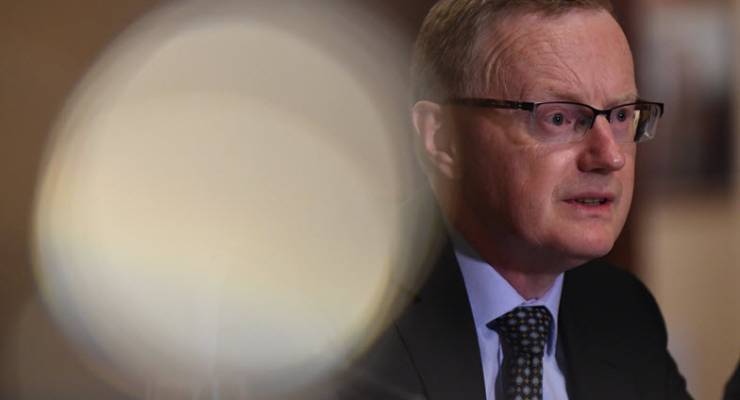
The Reserve Bank has begun the year on a strongly optimistic note, and, in doing so, is risking real damage to its reputation if its positive view of the economy fails to materialise.
The central bank has managed to reach its inflation target just twice since 2014. It has routinely overestimated wage growth. It began 2019 with wildly optimistic economic growth forecasts before being belatedly forced to cut interest rates three times — as some commentators had long been predicting.
Now, after yesterday’s decision to leave rates on hold, there are already grumblings that it needs to remove the rose-tinted glasses.
Even if RBA Governor Philip Lowe’s “gentle turning point” phrase has now been abandoned in the wake of a deterioration in the economy in the second half of 2019, the bank appears determined to go into 2020 with the same forced smile with which it entered 2019 — bushfires, wage stagnation, global pandemics and political instability not withstanding.
It’s worth recalling just how wrong the RBA got the economy this time last year.
Back then, Lowe forecast the economy to “grow by around 3% this year and a little less in 2020”. There were “downside risks” and the Sydney and Melbourne housing markets were undergoing a correction but unemployment was around 5% and forecast to ease to around 4.75% “over the next couple of years”. This would “see some further lift in wages growth over time,” Lowe believed.
The property markets came to life in the second half of the year but otherwise none of that turned out to be correct.
Economic growth was 1.7% in the year to September, or “around” half of the forecast. Wages growth fell rather than rose to an annual 2.2% for the wage price index (WPI) in the year to September.
It’s true that inflation remained steady rather than falling further, but the jobs market continued to weaken from the strong growth it enjoyed under Malcolm Turnbull and is now nearly back at long-term average growth.
Despite all that and the events of summer — not just the fires and coronavirus but an apparent worsening in retail conditions that is driving shopping chain after chain into administration — Lowe maintained a sunny smile in his post-meeting statement yesterday.
The central scenario is for the Australian economy to grow by around 2¾ per cent this year and 3 per cent next year, which would be a step up from the growth rates over the past two years. In the short term, the bushfires and the coronavirus outbreak will temporarily weigh on domestic growth…
The household sector has been adjusting to a protracted period of slow wages growth and, last year, to a decline in housing prices, with the result that consumption has been quite weak.
Following this period of balance-sheet adjustment, consumption growth is expected to pick up gradually. The overall outlook is also being supported by the low level of interest rates, recent tax refunds, ongoing spending on infrastructure, a brighter outlook for the resources sector and, later this year, an expected recovery in residential construction.
Again with the tax refunds!
Outside the government, only the RBA is still arguing that the government’s tax offset payments had any noteworthy stimulatory impact, rather than being banked by worried consumers. In fact, even the government itself has now abandoned claiming they’ll be the panacea Scott Morrison and Josh Frydenberg were insisting eight months ago
Lowe thinks unemployment is now set to gradually decline “to a little below 5 per cent in 2021.”
Doubtless burnt by the dozen wildly wrong forecasts the bank has previously made about wages growth, Lowe now says “wages growth is subdued and is expected to remain at around its current rate for some time yet. A further gradual lift in wages growth would be a welcome development and is needed for inflation to be sustainably within the 2–3 per cent target range.”
Nothing about when it would happen.
So where do we go from here?
Lowe has a speech this afternoon on the year ahead, and it will give us an indication of what kind of forecasts we’ll see in the first Statement of Monetary Policy for the year, which comes out Friday.
The November statement was a belated recognition by the bank that the government’s wage stagnation strategy had severely crimped economic growth. It had wages and unemployment steady or barely improving until the end of 2021.
Friday’s statement extends the forecast period out to mid-2022. It will be interesting to see whether the bank sticks to its November gloom or displays the same spring in its step that animated Lowe yesterday.









Crikey is committed to hosting lively discussions. Help us keep the conversation useful, interesting and welcoming. We aim to publish comments quickly in the interest of promoting robust conversation, but we’re a small team and we deploy filters to protect against legal risk. Occasionally your comment may be held up while we review, but we’re working as fast as we can to keep the conversation rolling.
The Crikey comment section is members-only content. Please subscribe to leave a comment.
The Crikey comment section is members-only content. Please login to leave a comment.